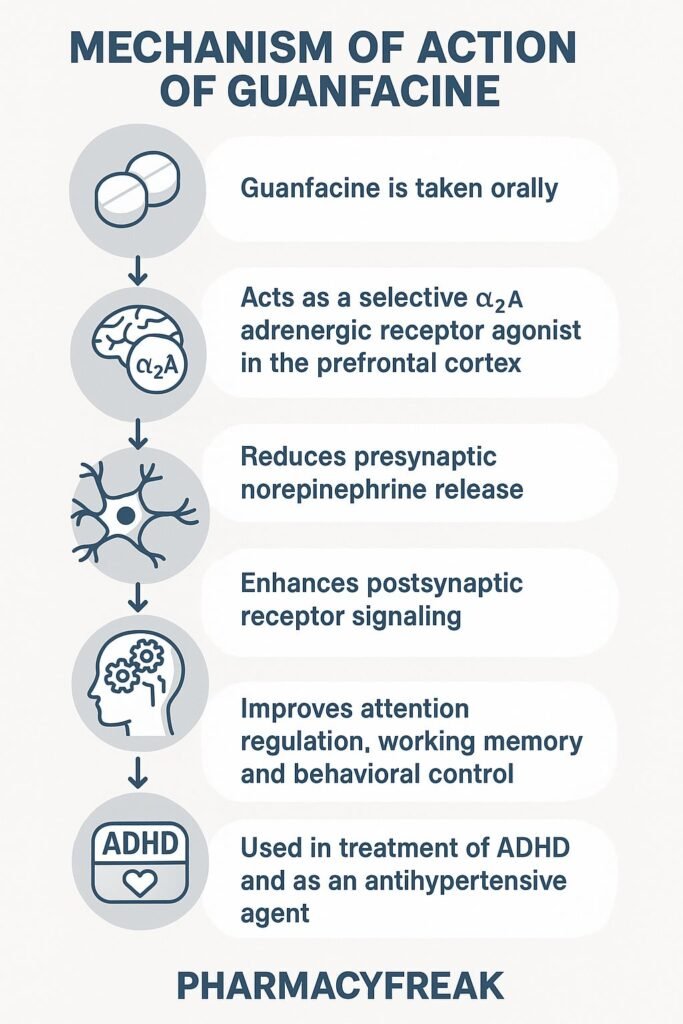Table of Contents
Introduction
Guanfacine is a selective α₂A‑adrenergic receptor agonist used in treating ADHD and for managing hypertension. It enhances prefrontal cortex functioning by activating postsynaptic α₂A receptors, resulting in improved attention, impulse control, and reduced sympathetic tone.
Step-by-Step Mechanism of Action
- Selective α₂A Receptor Agonism
Guanfacine binds preferentially to α₂A receptors in the prefrontal cortex. - Inhibition of cAMP Signaling
This activation reduces cAMP production, closing HCN and KCNQ potassium channels. - Increased Neuronal Firing Efficiency
Stabilization of membrane potentials fosters enhanced neuronal signaling for working memory and attention. - Reduced Sympathetic Output
In the brainstem, α₂A activation diminishes sympathetic activity, lowering heart rate and blood pressure. - Clinical Improvement in ADHD
Enhanced prefrontal regulation improves attention span, decreases distractibility, and reduces impulsivity.

Pharmacokinetic Parameters
| Parameter | Value |
|---|---|
| Bioavailability | ~70–80% (oral) |
| Time to Peak (Tₘₐₓ) | ~1–4 hours |
| Half‑Life | ~17 hours |
| Protein Binding | ~70% |
| Metabolism | Hepatic via CYP3A4 |
| Excretion | ~60% renal, ~20% fecal |
Clinical Uses
- ADHD (especially inattentive and hyperactive subtypes)
- Adjunctive therapy in ADHD when stimulants are inadequate
- Off-label: management of PTSD, tic disorders, insomnia
Adverse Effects
- Drowsiness, sedation
- Dry mouth
- Hypotension, bradycardia
- Headache, fatigue
- Rare: rebound hypertension upon abrupt discontinuation
Comparative Analysis
| Feature | Guanfacine ER | Clonidine (α₂ agonist) |
|---|---|---|
| Receptor Selectivity | α₂A‑selective | Non‑selective α₂ |
| Sedation Risk | Lower sedation | Higher sedation/hypotension |
| Duration | Once-daily dosing | Multiple daily doses required |
| ADHD Symptom Effect | Improves attention and impulse control | More sedation-focused effect |
MCQs
1. Guanfacine primarily acts as an agonist at which receptor?
A. β₁‑adrenergic
B. α₂A‑adrenergic
C. α₁‑adrenergic
D. α₂B‑adrenergic
Answer: B
2. In the prefrontal cortex, guanfacine reduces:
A. cGMP
B. cAMP
C. IP₃
D. DAG
Answer: B
3. The pharmacodynamic effect on neuronal firing is:
A. Increased membrane leak conductance
B. Stabilization of neuronal firing
C. Increased HCN channel activity
D. Inhibition of calcium influx
Answer: B
4. Guanfacine lowers blood pressure through:
A. α₁ blockade
B. Reduced sympathetic tone
C. β₂ antagonism
D. Vasodilatory prostaglandins
Answer: B
5. Compared with clonidine, guanfacine has:
A. More sedation
B. Greater prefrontal selectivity
C. Higher rebound hypertension risk
D. Shorter duration
Answer: B
6. What is the half-life of guanfacine?
A. 6 hours
B. 17 hours
C. 5 hours
D. 24 hours
Answer: B
7. Which enzyme metabolizes guanfacine?
A. CYP2D6
B. CYP3A4
C. CYP2C9
D. CYP1A2
Answer: B
8. A key side effect in children is:
A. Weight gain
B. Sedation
C. Incontinence
D. Tachycardia
Answer: B
9. Rebound hypertension may occur if guanfacine is:
A. Taken with food
B. Stopped abruptly
C. Combined with stimulants
D. Dosed nightly
Answer: B
10. Guanfacine’s ADHD efficacy is mainly due to:
A. Dopamine reuptake inhibition
B. Serotonin blockade
C. Prefrontal cortex modulation
D. GABA receptor activation
Answer: C
FAQs
1. Is guanfacine a stimulant?
No. It is a non-stimulant α₂A-agonist that improves PFC function.
2. Can it be used alone for ADHD?
Yes, or as an adjunct when stimulants alone are insufficient.
3. Does it cause sleepiness?
Yes, particularly when starting or increasing dosage.
4. Is withdrawal a concern?
Yes—gradual tapering is recommended to avoid rebound hypertension.
5. Is it safe for children?
It is FDA-approved for ADHD in pediatric patients and is well-tolerated.
References
- DrugBank – Guanfacine Drug Profile
- NCBI PMC – Role of α₂A Receptors in ADHD Treatment
- FDA Label – Intuniv (Guanfacine ER)
- Goodman & Gilman’s: The Pharmacological Basis of Therapeutics
Related Links

I am pursuing MBA in pharmaceutical management from NIPER Hyderabad with a strong academic record and proven success in national-level pharmacy entrance exams. I secured AIR 61 in NIPER 2024 (MS/M.Pharm) and AIR 27 in NIPER MBA, along with AIR 147 in GPAT 2024 and AIR 907 in GPAT 2023. I also achieved AIR 6 in AIIMS CRE-2025 for Drug Store Keeper and was selected as a Pharmacist (AIR 61) for ESIC. Additionally, I was the Runner-Up in Round 2 of the EY Case Study Competition.
At PharmacyFreak.com, I aim to guide future pharmacists through expert content, exam strategies, and insightful resources based on real experience and academic excellence.
Mail- harsh@pharmacyfreak.com

